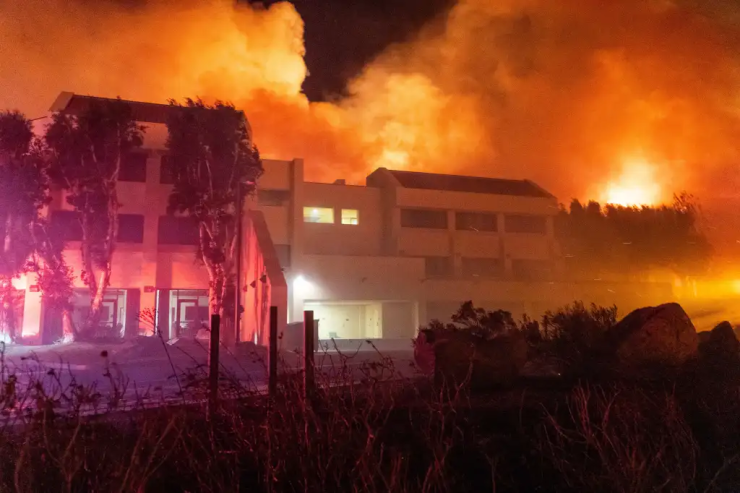Want unlimited access to top ideas and insights?
Natural disasters are evolving in scale and complexity, putting insurers and consumers alike on uneven footing when calculating risks, determining coverage eligibility and putting a price tag on recovery efforts.
These challenges aren't new, but technological shortcomings in the insurance space have propelled weather events ahead of the capabilities of insurers' risk models and left many homeowners either
Risk managers are hopeful of the promises that
George Hosfield, vice president and general manager of home insurance solutions at LexisNexis Risk Solutions, told Digital Insurance that his segment has seen strong consumer reception from a computer vision angle and aerial imagery being interpreted by computer vision.
"AI has been a pretty successful use case in our market, both on the underwriting side and on the claims side really, and I think that's been kind of the gateway for a number of other technologies to come into play," Hosfield said.
Read more:
A recent survey conducted by DI found that roughly 20% of insurers are turning to AI to help improve risk assessment and compliance monitoring. Other top uses included
More than half said their organization's AI investments to boost risk functions yielded results on par with initial estimates, while 7% said results have been slightly above expectations and 27% responded investments generated results significantly above expectations.
Jeff Batiste, senior vice president and general manager of LexisNexis' U.S. auto division, told DI that the "highly regulated" nature of the insurance industry means AI adoption has to be thoughtful and measured, not haphazard.
"For us it's really about operational efficiency inside of our business that allows us to increase both speed and accuracy of what we do in providing data, and on the customer side, it's really about removing friction from their workflows, really from the quoting process to the claims process," Batiste said.
Read more:
Below are insights from insurance professionals on how companies can employ new technology or data sources to stay ahead on risk assessment and possibly tap new markets in the process.

Insurers need to turn their systemic risk lenses inward
Insurers are the market experts in systemic risk, evaluating it across industries and geographies to manage portfolio exposure. For decades, if not centuries, they've analyzed risk clusters, stress-tested potential loss scenarios, and quantified financial exposure, perfecting underwriting strategies and optimizing policy terms and conditions.
Yet, despite this aptitude, many fail to apply the same level of scrutiny to their operations, especially when it comes to cyber risk. As cyber threats become more costly and grow more intricately connected, these insurers must start applying the same risk assessment rigor to their internal operations and digital infrastructure.
Insurance companies, like their portfolios, are not immune to cyber threats. They, too, rely on cloud-based third-party services to successfully carry out critical operational functions, ranging anywhere from email to payment processes. While these digital solutions have grossly increased workplace efficiency, their adoption does not come without the potential for wide-scale cascading consequences.
Read more:

Insurers are scrambling to keep pace with changing wildfire risks
The rise of destructive wildfires across the western U.S.—and especially in California—has reshaped the P&C insurance landscape. What was once perhaps considered a seasonal concern has become a year-round, multi-billion-dollar risk factor. As carriers navigate increasingly volatile conditions and rising loss ratios, a key question looms: Can risk models evolve fast enough to preserve market stability?
The answer depends on how quickly and effectively the industry adopts – and regulators approve - the next generation of
Traditional approaches to wildfire risk assessment are faltering in the face of accelerating losses, urban encroachment, and stressed suppression infrastructure. Broad-brush underwriting techniques that once sufficed now lead to inaccurate pricing, blanket rate increases, market subsidies that increase costs in non-wildfire areas and, in some cases, market exits.
Welcome to a
Read more:

New tech is helping insurers manage risks more effectively
Similar to leaders in other sectors, insurance executives are still in the infancy of trying to assess the extent to which emerging technologies such as Generative AI (Gen AI) will reshape business operations.
For an industry steeped in analyzing trends and risk probabilities, today's environment of evolving risks and emerging technologies represents opportunities and challenges for the sector and necessitates a robust and dynamic approach to risk management.
From regulatory changes to evolving weather patterns to shifting customer expectations, effectively utilizing emerging technologies to assist with risk management is critical for insurance leaders as they seek to not only adapt but also refine their operating strategies to ensure a resilient future for their business. While there is a myriad of examples to explore, below are three areas of note.
Read more:

The risks of EV charging fires for insurers are low, but not zero
Five years ago, I installed a Level 2 charger in my garage for my first electric vehicle (EV). I did everything by the book: I hired a licensed electrician, pulled the necessary permits, and made sure my panel could handle the load. Even still, I remember thinking, "What happens if something goes wrong?"
That question is no longer hypothetical for many homeowners and insurers. As EV adoption increases and residential charging becomes more normal,
EV fires, particularly those linked to charging, are still relatively uncommon. Studies suggest EVs catch fire at a lower rate than internal combustion engine vehicles. But when EV fires do happen—especially in residential settings—they're harder to extinguish, often more destructive, and more visible in the media.
Read more:

Plymouth Rock's bet on IoT for protecting homeowners
Plymouth Rock Assurance is doubling down on its investments in
Owen Williams, associate product manager at Plymouth Rock, told Digital Insurance that integrating the technology into their consumer-facing products is a more effective way of ensuring that customers are alerted to any issues and can access the tools more easily.
"I think one way that IOT technology has made a huge improvement is bundling it with a service component," Williams said. "So, I feel like just taking that extra step beyond just alerting homeowners of risks and being able to have a frictionless way for them to take action, I think it also has made a big difference in our adoption of some of these devices."
One example highlighted by Williams include water monitoring devices bundled with free plumbing repairs, which has led to "very high NPS scores from customers, around 93, who engage with the service," he said.
Read more:

How insurers can use geospatial data to find clients in high-risk areas
According to a
"The traditional approach to wildfire risk assessment has left many Californians without access to affordable property insurance coverage," Dale Porfilio, Triple-I chief insurance officer, said in a statement. "Our research shows that with more detailed, property-level analysis, insurers can confidently offer coverage in areas previously deemed too risky."
Triple-I's report, "
Read more:





